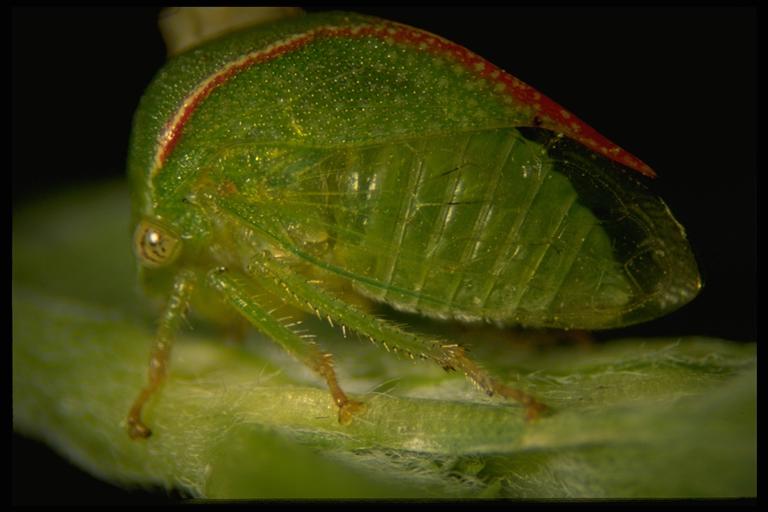
Threecornered alfalfa hopper, Spissistilus festinus Say (Homoptera: Membracidae), adult. Photo by Drees.
Common Name: Threecornered alfalfa hopper
Scientific Name: Spissistilus festinus Say
Order: Homoptera
Description: Threecornered alfalfa hoppers are members of a group of insects often called treehoppers because they actively hop and fly when disturbed. Adults are green, about 1/4 inch long, and are taller than wide due to an expanded segment (prothorax) behind the head that extends over the abdomen. Nymphs are also green and wingless, lacking the enlarged prothorax. Each segment of the body is adorned with a pair of large filaments or spines.
Other members of this group include treehoppers, some of which mimic thorns in their appearance. The twomarked treehopper, Enchenopa binotata (Say); the buffalo treehopper, Stictocephala bisonia Kopp & Yonke; and the whitemarked treehopper, Tricentrus albomaculatus Distant, are other common species.
Life Cycle: Winter is spent in the adult or egg stage. Eggs are inserted into plants by the females. Eggs hatch and develop through 5 stages (instars) before becoming winged adults. There are 3 to 4 generations per year.

Threecornered alfalfa hopper, Spissistilus festinus Say (Homoptera: Membracidae), nymph. Photo by Drees.
Habitat and Food Source(s): Threecornered alfalfa hoppers have a wide host range that includes alfalfa, clovers, cowpeas, grasses (Bermudagrass, Johnsongrass), small grains (barley, oats, wheat), soybeans, sunflowers, tomatoes, vetch and weeds. Adult and nymph stages can be found by sweeping soybean or alfalfa fields and weedy areas.
Pest Status, Damage: Adults and late stage (instar) nymphs “girdle” stems of soybeans and alfalfa with their feeding activities, causing stems to be brittle and plants to break at that site and fall over; nymphs feed on plant sap and may affect yield of a soybean crop when they occur in high numbers while pods are developing; medically harmless.
For additional information, contact your local Texas A&M AgriLife Extension Service agent or search for other state Extension offices.
Literature: Mueller 1980; Swan and Papp 1972.